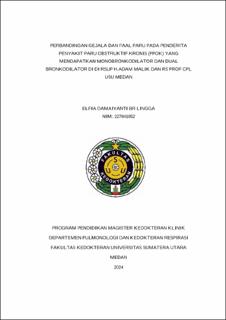| dc.contributor.advisor | Pandia, Pandiaman | |
| dc.contributor.advisor | Pradana, Andika | |
| dc.contributor.author | Lingga, Elfia Damaiyanti Br | |
| dc.date.accessioned | 2025-01-20T04:46:00Z | |
| dc.date.available | 2025-01-20T04:46:00Z | |
| dc.date.issued | 2024 | |
| dc.identifier.uri | https://repositori.usu.ac.id/handle/123456789/100330 | |
| dc.description.abstract | Background: Chronic obstructive pulmonary disease is one of the leading causes of death globally, with an estimated 3.23 million deaths. The Global Initiative for Chronic Obstructive Lung Disease (GOLD) guides the treatment of chronic obstructive pulmonary disease patients with monobronchodilators or dual bronchodilators. Assessment of prognosis of therapeutic outcomes is necessary to monitor the impact of interventions and recovery of daily activities, and to prevent acute attacks and improve productivity of patients with chronic obstructive lung disease. Objectives: This study aims to determine the comparison between symptoms and lung function in patients with chronic obstructive pulmonary disease who receive monobronchodilators and dual bronchodilators.Methods: This study is a retrospective cohort study. The study samples were patients diagnosed with chronic obstructive pulmonary disease (COPD) and undergoing monotherapy or dual therapy treatment at Haji Adam Malik Hospital Medan and Prof. Chairuddin Panusunan Lubis (CPL) Hospital Medan who met the inclusion and exclusion criteria based on medical records. Inclusion criteria: patients diagnosed with chronic obstructive pulmonary disease, aged > 18 years, and undergoing monobronchodilator or dual bronchodilator therapy for at least 3 months. Exclusion criteria: Patients had other lung diseases such as lung cancer, tuberculosis and others, psychiatric disorders, and were not compliant with treatment (therapy). Symptoms were measured with The COPD Assessment Test (CAT) and lung function was measured with spirometry. Data were analyzed by independent sample t test or Mann Whitney test. Results: The majority of patients were male (87.1%) and aged > 60 years (62.4%), the most patients were smokers (84.7%), and the most use of therapy was monobronchodilator (62.4%), there were differences in symptoms and lung fauna in patients with monobronchodilator and dualbronchodilator. Conclusion: Dualbronchodilators are more effective in increasing FEV1 values in patients than monobronchodilators. The average FEV1 value in patients using monobronchodilators decreased by 5.589% and the FEV1 value in patients using dualbronchodilators increased by 13.907%. | en_US |
| dc.language.iso | id | en_US |
| dc.publisher | Universitas Sumatera Utara | en_US |
| dc.subject | dual therapy | en_US |
| dc.subject | lung function | en_US |
| dc.subject | symptoms | en_US |
| dc.subject | monobronchodilator | en_US |
| dc.subject | dualbronchodilator chronic obstructive pulmonary disease | en_US |
| dc.title | Perbandingan Gejala dan Faal Paru pada Penderita Penyakit Paru Obstruktif Kronis (PPOK) yang Mendapatkan Monobronkodilator dan Dual Bronkodilator di RSUP H.Adam Malik dan RS Prof CPL USU Medan | en_US |
| dc.title.alternative | Comparison of Symptoms and Lung Function in Patients with Chronic Obstructive Pulmonary Disease (COPD) Receiving Monobronchodilators and Dual Bronchodilators at H.Adam Malik Hospital and Prof CPL Hospital USU Medan | en_US |
| dc.type | Thesis | en_US |
| dc.identifier.nim | NIM227041052 | |
| dc.identifier.nidn | NIDN0019056110 | |
| dc.identifier.nidn | NIDN0023128907 | |
| dc.identifier.kodeprodi | KODEPRODI11103#Ilmu Kedokteran Klinis | |
| dc.description.pages | 86 Pages | en_US |
| dc.description.type | Tesis Magister | en_US |
| dc.subject.sdgs | SDGs 3. Good Health And Well Being | en_US |


